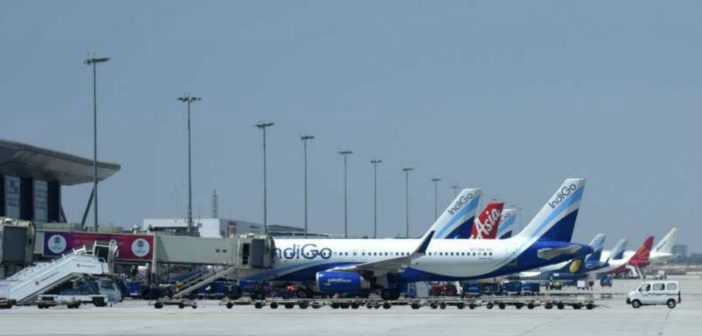Aircraft movements refer to the total number of take-offs and landings at an airport. One complete flight involving both an arrival and a departure would count as two separate aircraft movements. This figure includes passenger, cargo, and charter operations, among others. Domestic aircraft movements surged from 12.57 lakh in 2014-15 to a peak of 22.52 lakh in 2023-24, crossing pre-pandemic levels while international aircraft movements are yet to reach the pre-pandemic levels.
On 17 November 2024, India’s aviation sector achieved a remarkable milestone by recording over 500,000 domestic passengers in a single day across 3,173 flights. This historic achievement reflects the impressive growth of the country’s aviation industry. Once marked by modest traffic and limited connectivity, India has now become one of the fastest-growing aviation markets in the world.
This surge in air traffic can be attributed to several factors: rising incomes, urbanization, increased tourism, government initiatives like UDAN (Ude Desh ka Aam Naagrik), and investments in airport infrastructure. The entry of low-cost carriers and competitive pricing has further democratized air travel, enabling a larger segment of the population to take to the skies. On the international front, the lifting of pandemic-era restrictions and robust demand for overseas travel have significantly boosted passenger numbers.
However, this growth hasn’t come without challenges. Rising airfares, absence of robust competition, infrastructure bottlenecks, and the environmental impact of increased air traffic remain pressing concerns. In this story, we delve into the trends shaping domestic and international air traffic movements in India over the past decade, offering insights into the sector’s evolution and its implications for the future.
The data for the story has sourced taken from Dataful’s collection of datasets on Air Traffic, based on the figures published by the Airports Authority of India. It should be noted that the data is as of November 2024.
Aircraft movements refer to the total number of take-offs and landings at an airport. For the purpose of tracking airport traffic, each take-off (departure) and each landing (arrival) is counted as one movement. Thus, one complete flight involving both an arrival and a departure would count as two separate aircraft movements. This figure includes passenger, cargo, and charter operations, among others.
Number of daily aircraft movements has almost doubled in the last decade
India’s aviation sector has experienced significant growth in aircraft movements over the past decade. Domestic aircraft movements surged from 12.57 lakh in 2014-15 to a peak of 22.52 lakh in 2023-24. In simpler terms, the number of movements recorded each day has gone up from around 3,447 in 2014-15 to 6,171 in 2023-24. International movements followed a similar trajectory, growing from 3.45 lakh in 2014-15 to 4.25 lakh in 2023-24 or 946 per day in 2014-15 to 1165 per day in 2023-24.
Data indicates that the COVID-19 pandemic caused a sharp decline in 2020-21, with domestic and international movements dropping to less than half the previous year’s figures. While domestic movements recovered from the pandemic’s impact in 2023-24, the international movements are yet to reach the pre-pandemic levels. With four months remaining in 2024-25, it is anticipated that the figures will continue to rise at the current pace and surpass pre-pandemic levels.
Higher volume of movements has been recorded in third quarter of each fiscal year
The quarterly trends in domestic and international aircraft movements clearly show significant growth and fluctuations driven by seasonal factors and the impact of the pandemic. In the pre-pandemic years, from 2014 to 2019, domestic movements consistently increased across all quarters, with Q3 (October-December) typically seeing the highest traffic due to peak travel periods like festivals and holidays. Even monthly data reveals this trend with more movement recorded in the months from October to December and January compared to other months. International movements followed a similar upward trend, though at a slower pace, with Q3 again showing the highest volume. The pandemic caused a sharp decline in both domestic and international aircraft movements, particularly in Q1 of 2020-21, when movements plummeted due to lockdowns and travel restrictions.
Post-pandemic, both domestic and international aviation have been recovering strongly. As seen earlier, the domestic movements surpassed pre-pandemic levels by 2022-23 while international movements, though staged a recovery, are yet to surpass those levels. In 2023-24, record domestic movements were recorded, with Q3 hitting a high of 5.77 lakh, while international movements also saw steady growth, with Q4 reaching 1.11 lakh. The first two quarters of 2024-25 show strong performance, with domestic movements reaching 5.91 lakh in Q1, and international movements hitting 1.16 lakh in Q2. For 2024-25, as mentioned earlier, the values are up to November 2024 only.
Southern and western regions have historically dominated in both domestic and international movements
Historically, the Southern and Western regions have dominated, with Southern India leading both domestic and international movements due to hubs like Bengaluru, Chennai, and Hyderabad. For instance, in 2023-24, Southern India accounted for 6.74 lakh domestic and 1.76 lakh international air traffic movements. Western India, with key airports like Mumbai and Ahmedabad, recorded domestic traffic of 6.97 lakh movements and nearly 1.04 lakh international movements. Northern India, driven by Delhi’s pivotal role, showed balanced growth across both traffic types, while Eastern and Northeastern regions saw significantly lower activity, reflecting limited international connections.
The COVID-19 pandemic had a profound impact on all regions, with domestic and international movements plummeting in 2020-21. Southern and Western India, being the busiest regions, faced the steepest declines in absolute numbers but showed stronger recovery post-pandemic. For example, Southern India’s domestic movements fell to 3.32 lakh in 2020-21 but rebounded to 6.74 lakh by 2023-24. Conversely, Northeastern India, which already had low volumes, faced proportionally smaller declines but remains underdeveloped in terms of air traffic. The pandemic also highlighted a disparity between international and domestic recovery as seen earlier with international movements recovering slower across all regions.



